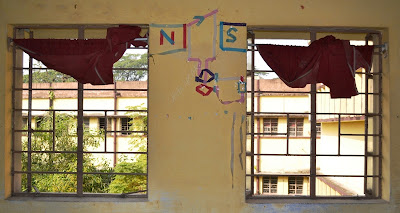Special Issue: Part 4
(Un)Common Landscapes and Ruptured Memories: Auto-ethnographies of North Bengal
Walls: The Geek Shall Inherit the Earth
By Sumana Roy
"Engineering colleges are anthropological curiosities."
Five years ago, I began teaching at the Humanities department in a government engineering college in Jalpaiguri, a district town in North Bengal, India. ‘Engineering English’ was the brief given to me on my first day at the job. That course, its syllabus set by a controlling technological university in Calcutta, was itself an anthropological inheritance I could do without: in the course of a semester I was to produce English-speaking engineers who would be linguistically equipped to work for richer economies in the West.
The majority of my students were second and third language English users. They were more scared of the preposition than I had ever been of Integral Calculus. Every classroom encounter brought some new blooper, every corridor conversation a self-critique. Increasingly frustrated with the near non-existent role of the Humanities in the ideating technology of my students and colleagues from the engineering sciences, I would gradually have to get used to a new kind of marginalization. A few months into my job, I, perhaps to avoid the curious gaze of what in my mind was the beehive of the non-humanities, found myself observing the walls of classrooms and corridors and toilets and offices of the institute. It might have also been the metaphor turning literal: I was letting walls grow around me.
Fig.1, 2: The scribbling over walls
It wasn’t the writing on the walls alone that made me feel like a creature from another planet. All around me were signs, geometrical figures, letters and numerals, arranged in such a way that what must have been a meaningful code to engineers began to look like installation art and cave paintings to me.
Fig. 3,4 & 5: The Wall Circuits....
When I discovered ‘Integrate the World’ written on a broken switchboard by students of the Electronics and Communications Engineering department, the phrase began to sound like a pop idiom.
Fig. 6: The Wall is Integrated...
Or a series of nuts and bolts, rusty and perhaps of no use, nailed into the skin of the wall, began to walk in my dreams: it resembled a centipede.
Fig. 7: The Centipede
The college is now fifty years old, and it wears its history on its walls. Not in commemorative plaques, but in the sketches of monsoon moss that refuses to leave its walls. Like many government buildings that run on the bureaucratic psychology of nothing-can-be-thrown, old switch boxes, their intestines exposed, remain nailed to walls. Those damp faces on the walls, broken apparatuses, electric lines in ruins, mathematical equations scribbled on walls as aid to writing examinations, missing letters from words, broken pipes hanging from bureaucratic signs, fire extinguishers hanging from walls like baby kangaroos from pouches – this was a new world, a new found land.
It was not the walls inside the college alone which carried the secular stigmata of alienation. I found that the walls outside were no less curious. On the walls of a building officially marked ‘abandoned’, someone, in all likelihood a student, had carved a love story with hearts and initials of the lover; in another place was an advert for instant noodles which said ‘Seasoning inside’, as if inside the wall.
Fig. 17 & 18: Loving the Wall, Inside.....
And just outside the campus, I found the strangest wall I’ve ever encountered: a message saying that Netaji Subhash Chandra Bose, the Indian freedom fighter said to have died in an air crash in 1945, would return as ‘the leader of the nation, may be the world’.
I cannot exactly say what led me to begin photographing these walls. What kind of documentation of my psychological life was I aiming for? I knew I wasn’t aiming for prettiness. So when I was ‘caught’ photographing walls, I was often made to feel like a spy. ‘A wall, seriously? You find this worth photographing?’
I’d be taunted from time to time, by students and colleagues. It would leave the administration uneasy, their lacks written on the wall as it were. Sometimes I found myself wondering about what my students thought of my fetish. I found the answer one afternoon when a young boy, not more than twenty, came and asked me, ‘Is this what the Humanities does – treat unimportant things like walls as important?’. In response, I asked him to pose for me in a photograph, a wall magazine to his left.
Fig. 20, 21, 22 & 23: The Wall Codes...
I’d be taunted from time to time, by students and colleagues. It would leave the administration uneasy, their lacks written on the wall as it were. Sometimes I found myself wondering about what my students thought of my fetish. I found the answer one afternoon when a young boy, not more than twenty, came and asked me, ‘Is this what the Humanities does – treat unimportant things like walls as important?’. In response, I asked him to pose for me in a photograph, a wall magazine to his left.
All of this together bred a disciplinary isolation in me. In them was the resounding moral: The geek shall inherit the earth. The walls became versions of Lines of Control. Until one day, while driving out of the campus, I found a red wall painted with the words ‘Open Happiness’. It was an advert for Coca Cola, and as if by a miraculous coincidence, I found a young schoolgirl pass by with an open umbrella. And I suddenly became both: the girl and the wall.
Fig. 24: The Wall opens to happiness....
Author’s Bio- Note:
Sumana Roy writes from Siliguri, a small town in sub-Himalayan Bengal. She can be contacted at www.sumanaroy.com

























Beautiful, Sumana. Just beautiful.
ReplyDeleteExcellent,a unique presentation...Smriti Sengupta.
ReplyDeleteThe eye has a gift called vision!
ReplyDeleteBeautiful. I especially loved figure 20. It says HI!....and loads of them.
ReplyDelete